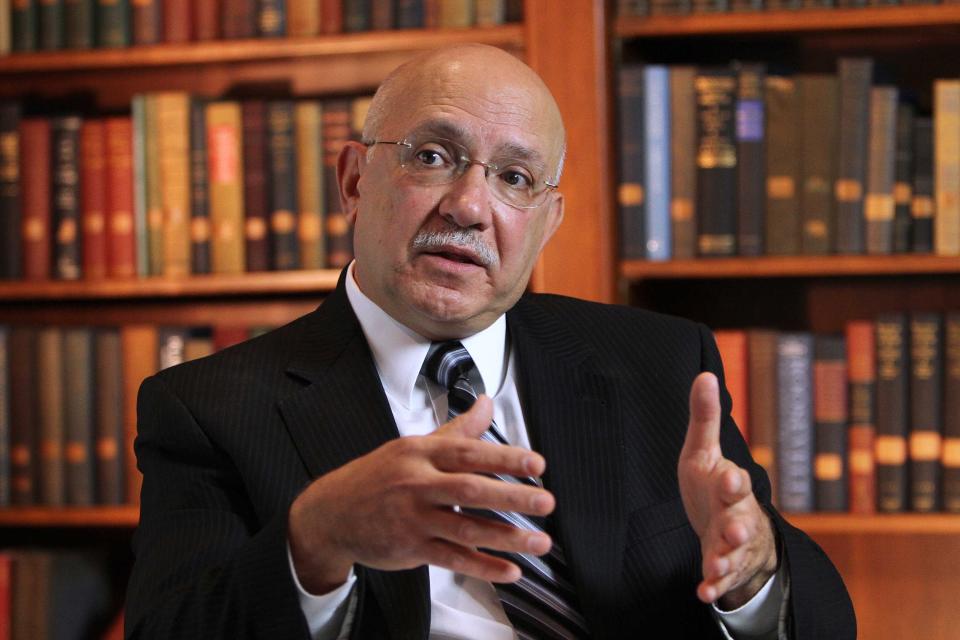CHEYENNE — Project Cosmo, an $800 million, 750,000-square-foot data center development in south Cheyenne, has been discussed since work began to recruit the project as far back as seven years ago.
On Tuesday, it was officially unveiled as a data center for Meta, the parent company of Facebook and Instagram.
The announcement was made to an audience of around 100 people at the Cheyenne Frontier Days Event Center, including U.S. Sens. John Barrasso and Cynthia Lummis, both R-Wyo., Wyoming Gov. Mark Gordon, Cheyenne Mayor Patrick Collins, and other elected officials from local and state government.
New investment in Meta data center
From left, Mayor Patrick Collins, Wyoming Business Council recruitment manager Wendy Lopez, U.S. Sen. Cynthia Lummis, U.S. Sen. John Barrasso, Meta Director of Community and Economic Development for Data Centers Bradley Davis, Gov. Mark Gordon and Cheyenne LEADS CEO Betsey Hale pose together for a picture during a new Meta data center investment announcement event in the Cheyenne Frontier Days Event Center on Tuesday.
“I’m really proud to welcome Meta to Cheyenne and Wyoming,” Collins said to announce the business behind Project Cosmo, followed by applause from attendees.
Meta Director of Community and Economic Development for Data Centers Bradley Davis said this development will create around 1,000 construction jobs over the next two years, and establish 100 permanent jobs in the area.
Davis described the data center as the engine that allows them to power apps and services like Facebook, Instagram and WhatsApp. Simply put, it is a series of network computers that will store, process and transmit data around the globe. This data center, in particular, is being designed specifically to handle artificial intelligence (AI) workloads.
“It’s cutting-edge technology,” Davis said. “Couldn’t be more excited to have it here in Cheyenne.”
When Collins first met with Meta about the project, he shared concerns about water usage in the area. Davis said it is a goal of the company to work with the needs of the communities where they develop data centers. In response, Meta chose to use a closed-loop liquid system, which Davis said is the most water-efficient option.
In addition, he said the center, located on a 960-acre parcel of land in the High Plains Business Park, will be powered 100% by renewable energy sources.
While the development worked in partnership with Black Hills Energy, Meta has yet to identify which renewable energy projects they will be using, but they are currently evaluating options.
Dustin McKen, Black Hills Energy program manager for Wyoming, said that if they are selected as the energy provider for the project, they will likely have to create or purchase renewable energy from other providers to transport to Cheyenne and provide to Meta to meet their renewable energy goal. He also noted that Black Hills customers should not expect to see any rate increases if they are selected as the energy provider.
Davis did not say how much water or energy use is estimated at this facility, but noted that Meta publishes annual environmental impact reports for all their data centers. He said he anticipates the numbers will be comparable to existing data centers of a similar size.
Though it is difficult to tell how much energy the project will need, some comparable data centers may provide some insight. Meta’s Stanton Springs Data Center in Newton County, Georgia, was a $1 billion investment in 2018, so it is slightly larger than Cheyenne’s facility. According to Meta environmental data reports, that facility consumed 636,266 megawatt hours in 2022, which is enough energy to power nearly 60,000 U.S. homes based on average annual consumption. In the same year, it emitted 535 metric tons of carbon dioxide, equivalent to the average emissions of 116 cars per year.
Lummis said it is important to keep energy production and consumption inside the Cowboy State.
“Wyoming produces 12 times more energy than it consumes. And we’ve gotten in the habit of taking our raw materials and sending them elsewhere,” said Lummis, who is from Cheyenne. “Well, that’s not the future of Wyoming. The future of Wyoming is generating our industry for use in our own state, by our own people, with industries that we invite in,” she said. “… Because we do it well, we can provide affordable, abundant, redundant energy provided by people who can make it cleaner than anywhere in the world.”
Collins expressed his excitement at the potential for millions of dollars in state and local taxes as a result of the project.
“Meta, I just want to say thank you for your investment in our community, and for the great partnership I know we’re going to have for years to come,” he said.
Davis said he envisioned this partnership as one where the trillion-dollar corporation can give back to the community in some way.
Meta’s community action grants program provides direct funding to schools, registered nonprofits and community organizations in locations where they have a data center. In Eagle Mountain, Utah, where Meta has a data center, Meta awarded an average of $210,000 in these grants to the community between 2020 and 2023.
The new facility will be Meta’s 25th data center worldwide, and it is expected to go online in 2027.
Signup bonus from





